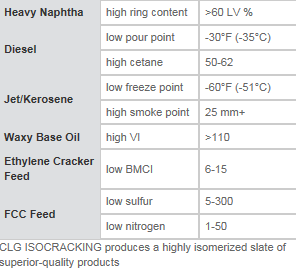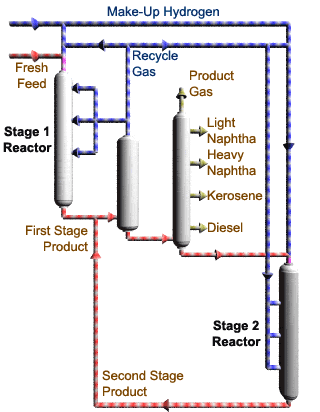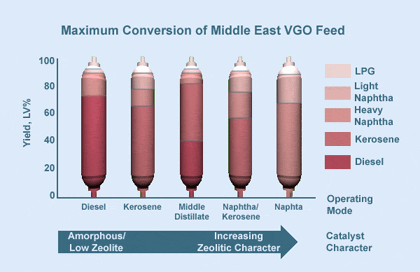ISOCRACKING
CLG has designed more than 100 hydroprocessing plants, with a combined daily operating capacity of more than two million barrels. Because CLG is experienced as a licensor, a refiner and a world-class engineering company, we offer expertise in hydrocracking that few companies can match. We make this expertise available to our customers through active research and development programs, pilot plant studies and a full range of engineering and technical support services.
ISOCRACKING differs from other hydrocracking processes in that it combines:
- Operations-oriented designs
- Amorphous, amorphous/zeolite and zeolite catalyst technology
- Optimized reactor systems
- Advanced internals technology
- Low fuel consumption

CLG’s ISOCRACKlNG technology offers you flexibility in crude oil buying decisions, the production of an array of products and operating efficiency, resulting in improved profitability.
We offer designs for all types of configurations, including:
- Single-Stage Once-Through (SSOT)
- Single-Stage Recycle (SSREC)
- Two-Stage Recycle (TSR)
Resid Hydroprocessing
Improving efficiency in residuum hydroprocessing is our expertise. Tightening environmental regulations and the economic realities of processing difficult feeds has led to further development of technology and catalysts to maximize returns from the bottom-of-the-barrel. Chevron introduced residuum hydrotreating, its fixed bed technology, more than 50 years ago. More than 30 years ago, Lummus Technology developed LC-FINING technology, its ebullating bed technology. Today, CLG offers both RDS and LC-FINING technologies for residuum hydroprocessing. Using CLG technologies, refiners achieve greater conversion to lighter products and have fewer feed-related operating problems while processing heavier feeds.
Both CLG’s RDS and LC-FINING processes provide deep removal of sulfur, nitrogen and metals, and hydrocarbon upgrading (cracking and hydrogen input) for maximum conversion of atmospheric/vacuum residue feedstocks to light clean products.
RDS is preferred where hydrogen input and deep removal of sulfur, nitrogen and metals are the primary objectives. RDS is well suited to pretreat Residuum Fluid Catalytic Cracking (RFCC) feedstocks.
LC-FINING is preferred where hydrocracking and deep removal of sulfur, nitrogen and metals are the primary objectives. LC-FINING is well suited to extra-heavy residue, bitumen and vacuum residue feedstocks, and has demonstrated long cycle lengths between turnarounds (approximately four years).
Since 1985, over 90 percent of the refiners who want to optimize downstream conversion from difficult feeds have chosen CLG technology because of its superior economics. CLG offers its licensees a level of residuum hydroprocessing experience and expertise that is unparalleled to the competition. We share this expertise with our customers through active research and development programs, extensive pilot plant facilities and a full range of support services.
A Clear Upgrade Path
CLG offers a full-range of residuum conversion technologies and catalysts that can be tailored to help refiners optimize product quality, product yield, run length, capital investment and operating costs.
Flexible Upgrade Path
CLG’s ISOCRACKING SSOT configuration produces feedstocks with superior characteristics for FCC feeds, high VI lubes or ethylene plant feeds. Our latest development for SSOT employs a moderately high-pressure design in conjunction with a tailored catalyst system that provides unsurpassed hydrodenitrification and high hydrocracking activity.This moderate pressure hydrocracking requires a lower initial investment while providing refiners with the opportunity to economically revamp the unit for higher conversion, higher throughput, more difficult feeds and/or more stringent product quality specifications at a later date.
The SSREC configuration is used for high conversion processing of light feeds and for low capacity units, processing heavy feeds at low feed rates.

Increased yields and flexibility: The ISOCRACKING Two-Stage Recycle process is optimized for maximum yields of premium products with minimum hydrogen consumption. The first stage removes feed impurities and converts 20-50% of the feed. The second stage cracks the cleaned feed at lower temperatures.
Revamp for better products and better performance
The conventional approach to revamping an existing SSOT unit is to add additional reactor volume downstream or to add a "saturation reactor" to improve the quality of one or more products.CLG’s solution, Optimized Partial Conversion (OPC) ISOCRACKING, is less expensive and more flexible than the conventional methods. Using the Reverse Stage ISOCRACKING technology, the SSOT is converted to a partial or full recycle Two-Stage configuration by the addition of a small reactor upstream of the existing reactor.
The original single or "first stage" reactor effluent system removes organic nitrogen and other catalyst poisons, so that a portion of the fractionator bottoms can be recycled to the new "clean" second stage reactor. This produces high conversion to very high-quality products at less investment.
 CLG's cost-effective revamp solution achieves very high-quality products by adding a small reactor upstream. |
Tailored Catalyst Systems
ISOCRACKING® catalysts enable refiners to achieve higher yields and a wider range of products under a variety of process conditions and plant configurations. ISOCRACKING catalysts offer high temperature stability and proven performance with high end-point and high nitrogen feeds. The selectivity of these catalysts allows our agreement with Advanced Refining Technologies (ART) to tailor systems specifically designed to fit your product objectives.
ART offers a complete spectrum of base-metal amorphous and zeolitic catalysts and noble-metal zeolitic catalysts, so is able to help you meet all of your processing objectives.
to fit your product objectives.